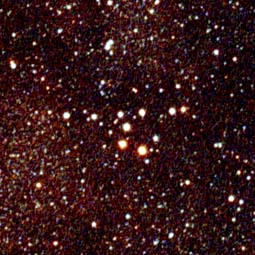
In stellar evolution, an FU Orionis star is a pre–main-sequence star which displays an extreme change in magnitude and spectral type. One example is the star V1057 Cyg, which became 6 magnitudes brighter and went from spectral type dKe to F-type supergiant. These stars are named after their type-star, FU Orionis.

Iota Orionis is a multiple star system in the equatorial constellation of Orion the hunter. It is the eighth-brightest member of Orion with an apparent visual magnitude of 2.77 and also the brightest member of the asterism known as Orion's Sword. It is a member of the NGC 1980 open cluster. From parallax measurements, it is located at a distance of roughly 2,300 light-years from the Sun.

In observational astronomy, an asterism is a popularly-known pattern or group of stars that can be seen in the night sky. This colloquial definition makes it appear quite similar to a constellation, but they differ mostly in that a constellation is an officially recognized area of the sky, while an asterism is a visually obvious collection of stars and the lines used to mentally connect them; as such, asterisms do not have officially determined boundaries and are therefore a more general concept which may refer to any identified pattern of stars. This distinction between terms remains somewhat inconsistent, varying among published sources. An asterism may be understood as an informal group of stars within the area of an official or defunct former constellation. Some include stars from more than one constellation.

Epsilon Cygni is multiple star system in the constellation of Cygnus. With an apparent visual magnitude of 2.48, it is readily visible to the naked eye at night as one of the brighter members of Cygnus. Based upon parallax measurement, Epsilon Cygni is about 73 light-years from the Sun.

V1974 Cygni or Nova Cygni 1992 was a relatively bright nova in the constellation Cygnus.

V1500 Cygni or Nova Cygni 1975 was a bright nova occurring in 1975 in the constellation Cygnus. It had the second highest intrinsic brightness of any nova of the 20th century, exceeded only by CP Puppis in 1942.

Iota Andromedae is a star in the constellation Andromeda. It has an apparent magnitude of +4.29 and is approximately 500 light years from Earth.
Pi¹ Cygni is a binary star in the northern constellation of Cygnus. It is visible to the naked eye, having a combined apparent visual magnitude of 4.66. The distance to this system can be roughly gauged by its annual parallax shift of 1.89 mas, which yields a separation of around 1,700 light years from the Sun, give or take a hundred light years.

Theta Cygni is a star in the northern constellation of Cygnus. It has an apparent visual magnitude of 4.5, so it can be seen from the northern hemisphere with the naked eye in sufficiently dark skies. Based upon parallax measurements, it is at a distance of about 59.8 light-years from the Earth. It is suspected of hosting an extrasolar planet.

Delta Cygni is a binary star of a combined third-magnitude in the constellation of Cygnus. It is also part of the Northern Cross asterism whose brightest star is Deneb. Based upon parallax measurements obtained during the Hipparcos mission, Delta Cygni is located roughly 165 light-years distant from the Sun.

Zeta Cygni is a binary star system in the northern constellation of Cygnus, the swan. It has an apparent visual magnitude of 3.26 and, based upon parallax measurements, is about 143 light-years away.

Tau Cygni, Latinised from τ Cygni, is a binary star system in the constellation Cygnus, approximately 69 light years away from Earth. This visual binary system has a period of 49.6 years.

32 Cygni is the Flamsteed designation for a binary star system in the Cygnus constellation. It is a 4th magnitude star, which can be seen with the naked eye under suitably dark skies. Parallax measurements give an estimated distance of 1,100 light-years (320 parsecs) from the Earth. However, Schröder et al. (2007) suggest the actual value, after correcting for Malmquist bias, may be closer to 1,174 light-years (360 parsecs). Although it is a spectrsocopic binary with components that cannot be separated visually, it has two entries in the Henry Draper Catalogue, with identical magnitudes and positions, but showing the spectral types of the two components.
V1057 Cygni (V1057 Cyg) is a FU Orionis-type variable star in the constellation of Cygnus. It has a spectral type of F and an apparent visual magnitude of approximately 11.660. It was the second FU Orionis-type variable discovered.
59 Cygni is a multiple star system in the northern constellation of Cygnus, located roughly 1,300 light years away from Earth. It is visible to the naked eye as a blue-white hued star with a combined apparent visual magnitude of 4.74.

55 Cygni is a blue supergiant star in the constellation Cygnus. It is thought to be a member of the Cygnus OB7 stellar association at about 2,700 light years.

BC Cygni is a red supergiant and pulsating variable star of spectral type M3.5Ia in the constellation Cygnus.

BI Cygni(BI Cyg, IRC +40408, BD+36 4025) is a red supergiant in the constellation Cygnus. It is an irregular variable star with a maximum brightness of magnitude 8.4 and a minimum of magnitude 9.9. It has a current mass of 20 M☉.









